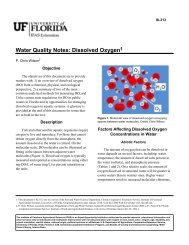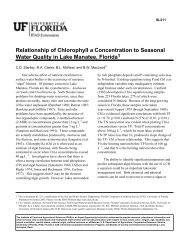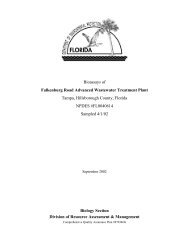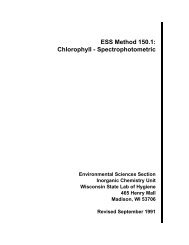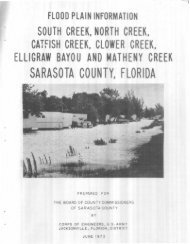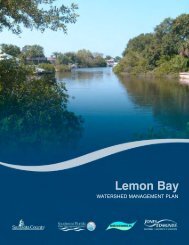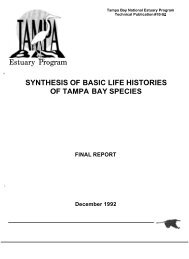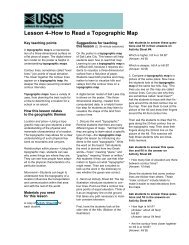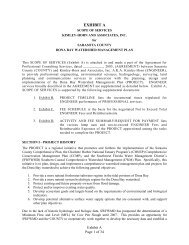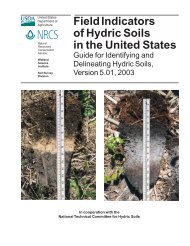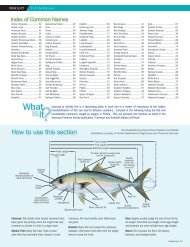Peace and Myakka River Water Quality Summary 2002 - Southwest ...
Peace and Myakka River Water Quality Summary 2002 - Southwest ...
Peace and Myakka River Water Quality Summary 2002 - Southwest ...
Create successful ePaper yourself
Turn your PDF publications into a flip-book with our unique Google optimized e-Paper software.
• Big Slough Canal near <strong>Myakka</strong> City (1999)• Big Slough Canal near North Port (1999).The ammonia nitrogen found in rivers <strong>and</strong> streams can come from a variety of natural<strong>and</strong> manmade sources. Exceedances of the un-ionized ammonia water qualityst<strong>and</strong>ard are often associated with anthropogenic activities, such as feedlots <strong>and</strong> otherconcentrated animal feeding operations, sewage treatment systems <strong>and</strong> industrialfacilities that make or use ammonia-based chemical products.Dissolved OxygenDissolved oxygen (DO) is a critical water quality parameter, due to the importance ofDO to the metabolic processes of all multi-celled aquatic organisms.DO concentrations are affected by a number of natural <strong>and</strong> man-made factors.Important natural factors include daily <strong>and</strong> seasonal temperature cycles (because thesolubility of oxygen in water is higher at lower water temperatures), photosynthesis(because photosynthesizing organisms release DO into the water column, increasing itsavailability) <strong>and</strong> respiration/decomposition processes (which cause DO concentrationsin the water column to decline).The primary manmade influences include the discharge of nutrients <strong>and</strong> organic wastesinto waterbodies, which can lead to increased eutrophication, higher rates ofphotosynthesis, respiration <strong>and</strong> decomposition, <strong>and</strong> larger daily <strong>and</strong> seasonalfluctuations in DO concentrations.The Florida st<strong>and</strong>ard for DO in fresh surface waters is 5 mgL/. Concentrations below 4mg/L are known to be stressful for most fish <strong>and</strong> many shellfish species.Concentrations below 2 mg/L are highly stressful <strong>and</strong> potentially lethal.During water years 1998 through 2001, DO concentrations below the 5 mg/L st<strong>and</strong>ardwere observed at least once at each station. Many of these instances were probablyassociated with natural factors, such as elevated water temperature. At severalstations, however, low DO levels were a frequent occurrence, observed on 25% or moreof the sampling dates. And for some stations the median annual DO concentration (thevalue measured on at least half the sampling dates in a given year) was less than the 5mg/L st<strong>and</strong>ard. The latter group of stations included:• <strong>Peace</strong> Creek Canal near Wahneta (water years 1998, 1999, 2000, <strong>and</strong> 2001)• Saddle Creek at Structure P-11 (1999, 2001)• <strong>Peace</strong> <strong>River</strong> at Bartow (1998, 1999, 2000, 2001)• Shell Creek near Punta Gorda (1998)• Deer Prairie Slough near North Port (2000, 2001)• Big Slough Canal near North Port (2001).The frequent periods of low DO availability occurring at these stations presumably hadnegative impacts on local populations of fish <strong>and</strong> other aquatic organisms.13



